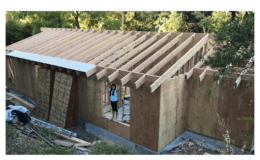Thanks so much for doing this research, and writing this article, Michael. It is so easy to look away, and not look at people in difficult straits. I didn’t realize there were so many homeless people in CV. I think public restrooms would be a great first step to treat these people with dignity.
SF Homeless Project: Castro Valley Creek homeless community, my neighbors
- By : Michael Kusiak
- Category : Alameda County Sheriff, Community, Featured Story, SF Homeless Project
- Tags: Homeless

Castro Valley Matters is participating in the SF Homeless Project, an effort by over 70 Bay Area organizations to tell stories of homelessness in San Francisco and the Bay Area.
The Castro Valley Creek is a sudden burst of natural beauty sandwiched between suburban strip malls, an office park, a small pocket park, and the Castro Valley Library. I noticed recently that more people who didn’t seem to have any other place to go were hanging out along the creek. It is a relatively safe refuge to be homeless in Castro Valley.
Back in 2007, the Alameda County Flood Control & Water Conservation District unearthed and restored the Castro Valley Creek between Castro Valley Boulevard and Norbridge Avenue into a “naturalized creek.” My boys and I often walk or ride our bikes past the Creek on our way to the Castro Valley Library or Rudy’s Donuts on the weekend.
A few months after we moved into our home in 2009, the Castro Valley Library opened. You can see the reading room of the Castro Valley Library from my backyard. We share this neighborhood with the homeless who have made the Castro Valley Creek their home.
Last week, I spent some time meeting the people who live and sleep outside, so close to where my family and I sleep at night in our home.
The community along Castro Valley Creek
 Rhonda was evicted from her Castro Valley mobile home, where she had lived for 22-years. She is now homeless and sleeps near Castro Valley Creek.
Rhonda was evicted from her Castro Valley mobile home, where she had lived for 22-years. She is now homeless and sleeps near Castro Valley Creek.
She estimated the homeless population around the Creek to be about 20 people, a community where everyone knows each other, all mostly around age 60.
Rhonda said she felt “so disregarded, so disenfranchised.” Being homeless was the “was the last thing I thought would happen. It happened so fast,” she said. “That’s my life,” she said, “If it disappears, it disappears.”
At one time Rhonda worked at Safeway. She suffers from depression. She said that her biggest safety issue is being hassled by others in the homeless community. She optimistically calls her current situation an “extended urban camping trip” and believes that “it will all work out in the end.”

Larry used to live in a mobile home on Castro Valley Boulevard. He could not pay his rent and was evicted. Most of his possessions were thrown away, some of his stuff is in a storage unit. He lives off his Social Security. During the winter, he went to a shelter.

She did not speak, but she accepted my offer of a bottle of water last Tuesday, when it got hot outside. She has created a space for herself next the building behind the Kentucky Fried Chicken and next to the Castro Valley Creek. The area around the Castro Valley Creek provides ample shade.
Carts & Debris

In the area around the Kentucky Fried Chicken and CVS, there is a lot of debris and overflowing shopping carts. Rhonda said that she and other people in her situation find places to hide their belongings throughout town. When I walked around the Creek, it was not clear at times what were personal possessions and what were items that had simply been dumped.
Behind the CVS, I saw a man sleeping in between two couches that were made into a relatively private make-shift shelter. He declined to be photographed.
Alameda County Sheriff’s Office Role
“I really believe our homeless population is growing,” said Alameda County Sheriff’s Office Sergeant Bret Scheuller, who works closely with the homeless community in unincorporated Alameda County. Scheuller confirmed Rhonda’s estimate, saying that he sees a community of about 20-25 people in Castro Valley who are consistently homeless. Most of the population lives along the Hayward/Castro Valley border. Creek areas, over- and underpasses, and heavily shaded areas with trees are a big draw to the homeless community, he said.
The Sheriff’s Office works most directly with the homeless community, mainly because of complaints from the public. The most common complaints are about encampments along public property. “We try to have have an idea of who the homeless are,” Scheuller said. Most homeless will have a cellphone, and the Sheriff’s Office uses that information to reach out to the community to try to match them with what limited assistance is available.
While there are criminal elements in the community, dominated by trespassing on private property and drug use, assaults against the non-homeless population is not common, Scheuller said. “There is no law against being homeless,” he said. As Rhonda suggested, some violent crime tends to happen within the homeless community, particularly in encampments where there are incidents involving domestic violence, stabbings and weapons, he said.
“A lot of them deal with mental health issues,” Scheuller said. “With mental health issues, it’s unpredictable.”



